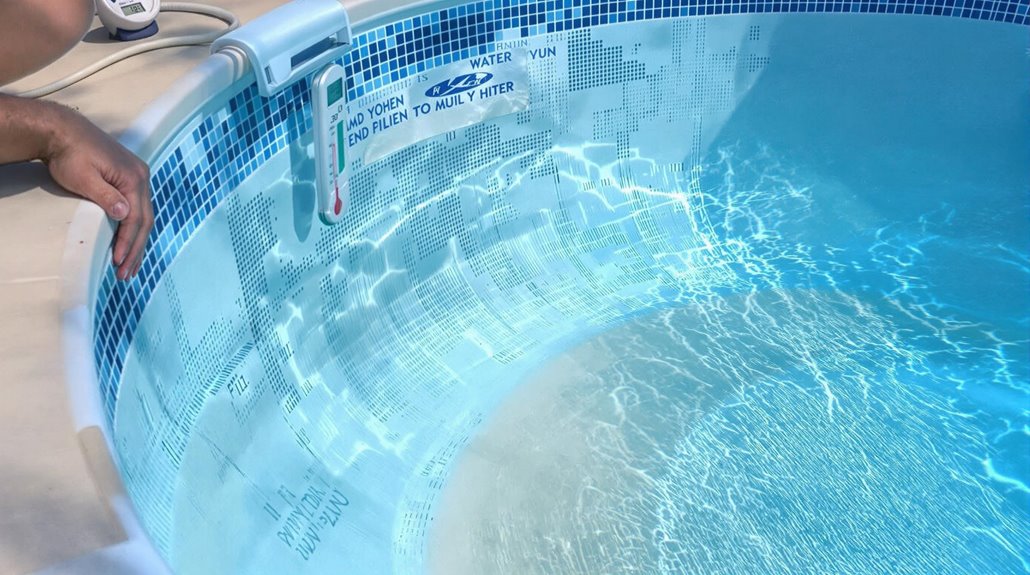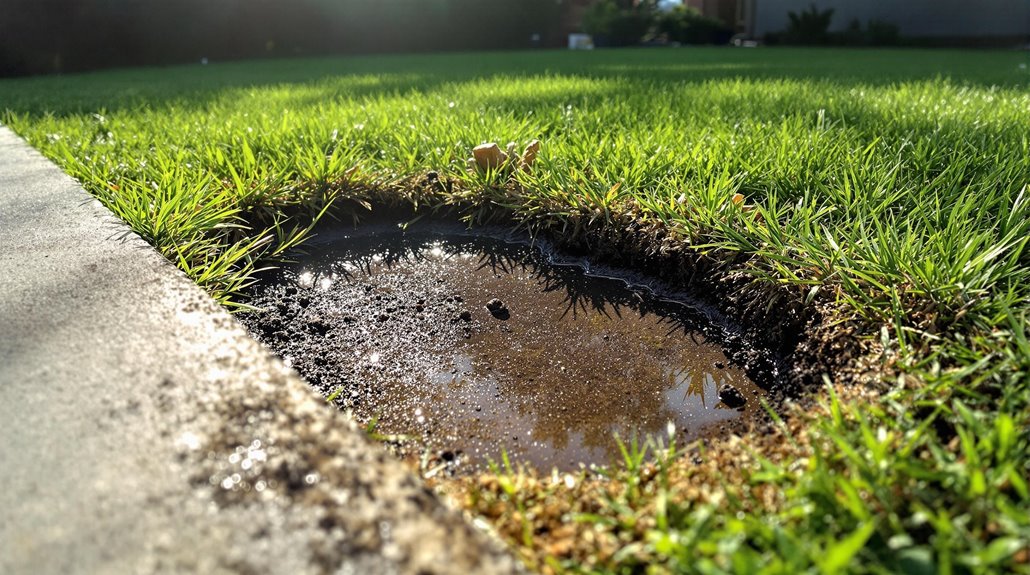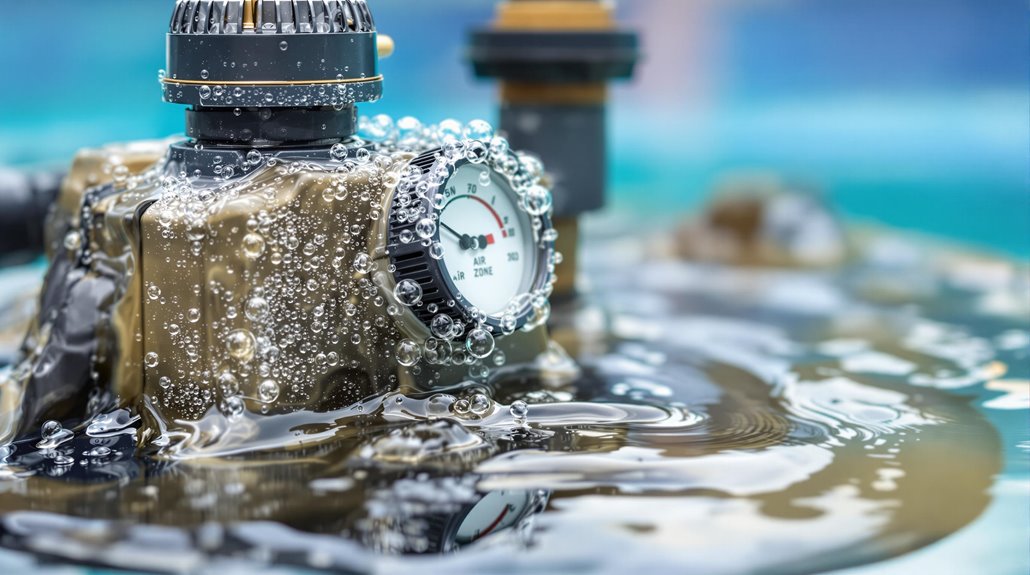You’ll need a leak detection service if your pool shows these critical warning signs: water loss exceeding one inch daily, visible cracks with reddish-brown stains, persistent wet spots in your yard, unstable chemical levels requiring frequent adjustments, or unusual sounds from equipment. These symptoms often indicate serious underlying issues that can lead to costly structural damage. Understanding the specific details of each warning sign helps you protect your pool investment.
Rapid and Unexplained Water Level Drops

Whilst gradual water loss through evaporation is normal for any pool, unexplained drops in water level often signal a more serious issue that necessitates professional attention. You’ll want to monitor your pool’s water level closely, especially if you notice losses exceeding one inch per day, which is a clear red flag for significant leaks.
In humid climates, water loss greater than 1/4 inch daily, or 1/2 inch in dry areas, surpasses typical evaporation rates and suggests structural problems. Be particularly watchful for sudden, random drops that can’t be explained by rain, splashing, or equipment use. Winter months deserve extra scrutiny as well – if you’re seeing accelerated water loss despite colder temperatures when evaporation should be minimal, it’s time to call in the experts for a thorough leak detection assessment.
Cracks and Damage Around Pool Structure
When you spot cracks developing in your pool’s structure, it’s essential to distinguish between harmless surface blemishes and serious structural damage that requires immediate attention. Look for deep cracks that run through the pool shell, especially if they’re wider than typical hairline fractures. You’ll know you’re dealing with structural issues if you notice reddish-brown stains around the cracks, indicating exposed rebar, or if the pool walls show signs of bulging or sinking.
Pay close attention to the soil around your pool. Visible voids, persistent dampness, or separated coping stones suggest underlying foundation problems. While shallow, spiderweb-like patterns often indicate normal aging, through-shell fractures accompanied by leaks or uneven pool floors demand professional leak detection services immediately.
Unusually Wet or Soft Spots in Your Yard

While your yard develops mysteriously wet or soft spots, you’re likely dealing with a pool leak that’s migrating underground. You’ll notice persistent saturation in certain areas, particularly near pool equipment or along slopes, even during dry spells. These waterlogged zones often appear as squishy patches that are difficult to walk on, indicating water has been seeping beneath the surface for some time.
Watch for signs of erosion or small sinkholes forming near return jets or equipment pads, since these suggest serious underground leaks. If you spot water trickling down slopes or persistent dampness around pool machinery, don’t wait – these are clear indicators of plumbing issues. Testing the water for chlorine can confirm whether it’s coming from your pool system rather than natural drainage problems.
Persistent Water Chemistry Issues
As your pool’s water chemistry becomes consistently challenging to maintain, you’re likely dealing with a leak that’s disrupting the delicate balance of chemicals. You’ll notice persistent chlorine imbalances requiring frequent adjustments, along with erratic pH levels that won’t stabilize despite regular testing and treatment.
Watch for telltale signs such as recurring algae growth that resists standard treatments, unexplained cloudy water, or stubborn calcium scaling on surfaces. If you’re constantly adding chemicals at an unusually high rate, or your alkalinity levels keep fluctuating beyond normal ranges, don’t just keep throwing money at endless treatments. These ongoing chemical stability issues often point to water loss through leaks, which continually introduce new water and throw off your pool’s chemical equilibrium. Maintaining proper pH balance is crucial for both water clarity and the effectiveness of other pool chemicals.
Strange Sounds and Equipment Performance Changes

Whenever your pool develops leaks, it often communicates through distinct sounds and equipment behavior changes that you shouldn’t ignore. Listen for dripping or trickling noises under pool covers, especially during quiet periods, and note any gurgling sounds that might indicate air entering through cracks. You’ll typically hear these sounds every few minutes if there’s a leak.
Watch your equipment closely for telling signs. If you notice wet spots around pumps or filters, or your autofill system runs constantly, you’re likely dealing with a leak. Pay attention to unexplained pressure drops in your filtration system and look for corrosion on equipment surfaces. These indicators, combined with unusual sounds, signal it’s time to call a leak detection specialist before the problem worsens and costs you more in repairs.
Frequently Asked Questions
How Much Does a Professional Pool Leak Detection Service Typically Cost?
Professional pool leak detection costs:
- Basic service: $225
- Overall range: $300-$1,000
- Inground pools: $400+
- Above-ground pools: $100-$700
Can I Perform Leak Detection Tests During Winter When Pool Is Closed?
Basic leak tests are possible in winter through dye testing, bucket tests, and water level monitoring. However, ice and limited pool access restrict thorough detection.
Will My Homeowner’s Insurance Cover Pool Leak Repairs?
Insurance covers pool leaks from storms, vandalism, falling trees, or sudden events. Normal wear and tear leaks are not covered.
How Long Does a Comprehensive Leak Detection Inspection Usually Take?
A comprehensive leak detection inspection takes 2-4 hours. Complex cases requiring pressure tests, dye checks and plumbing evaluations may need multiple visits.
Should I Drain My Pool Completely if a Leak Is Suspected?
Never drain completely – can damage pool structure. Maintain normal water level for leak detection.

